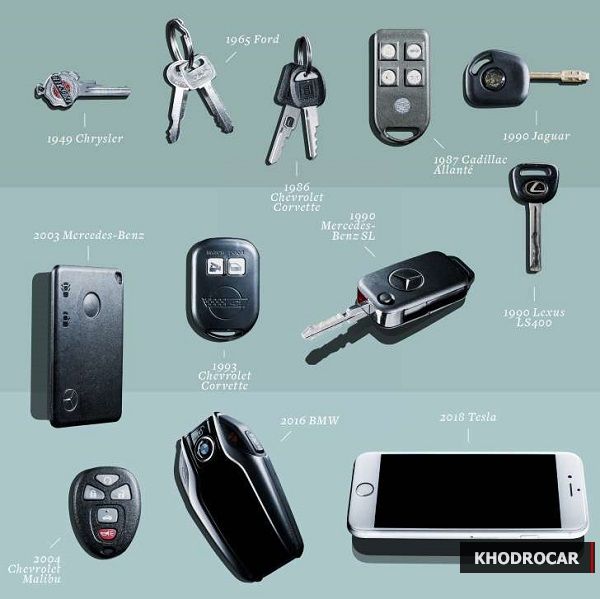You’ve lost them and you’ve found them. The once humble key has grown up, gained utility, and may soon become obsolete.
KhodroCar - Here are some highlights of the key’s evolution:

1949 Chrysler: While the first key that turned on a car’s ignition arrived in the early 20th century, it required the push of a button to engage the starter. In 1949, Chrysler introduces the modern key that starts the car with a turn of the ignition tumbler.
1965 Ford: Ford brings out its double-sided key still used today in many modern cars. Unlike the single-sided keys preceding it, this one has cuts on both sides, allowing it to be inserted into the tumbler in either orientation.
1986 Chevrolet Corvette: To make the Vette harder to steal, Chevy adds a coded resistor to the key that is needed to start the car. This Vehicle Anti-Theft System trickles down to most GM cars by the ’90s.
1987 Cadillac Allanté: The ’83 AMC/Renault Alliance has the earliest example of factory-installed remote entry capable of locking and unlocking the doors that we could find. But we couldn’t actually find one of these fobs, so we settled for that of another early adopter, the ’87 Cadillac Allanté. By the early ’90s, keyless-entry fobs are going mainstream, forever changing the lives of parking valets.
1990 Jaguar: Dubbed the Tibbe key, this odd shaft with an oval-shaped tip makes its first appearance in the 1989 Merkur Scorpio before being widely used by Jaguar in the 1990s; it also makes its way into many Ford products. The Tibbe key reappears for the 2010–13 Ford Transit Connect before disappearing for good.
1990 Lexus LS400: One of the first uses of the laser-cut key. This design provides an additional layer of security, mainly because it’s difficult to replicate.
1990 Mercedes-Benz SL: New for 1990, the Mercedes SL introduces a "switchblade” key that flips out of an integrated remote-locking fob. The design would be widely copied and continues to be used in most modern Volkswagens.
1993 Chevrolet Corvette: GM experiments with proximity-key technology in the ’93 C4. Unlike proximity fobs of today, the Passive Keyless Entry system couldn’t start the car—you still needed a traditional ignition key for that—but it could automatically lock and unlock the doors simply by detecting the fob close by.
2003 Mercedes-Benz: The first fully functional proximity key design is short-lived. Made for the 2003 model year to fit in a wallet like a credit card, Mercedes’ Smart Card lacks durability. A year later, Mercedes-Benz adapts the technology to work in a more robust fob. In 2004, Lexus releases its own version of the Smart Card and still offers one on select models and also as an accessory.
2004 Chevrolet Malibu: Remote start has been available in the aftermarket world for years, but GM is the first carmaker to offer the technology direct from the factory, forever changing the way we warm and cool our vehicles.
2016 BMW: BMW’s modern Display key makes its debut on the 7-series and attempts to mimic a smartphone by adding an LCD touchscreen. From 1000 feet away, the key can lock and unlock the doors, set climate control, and open the trunk. Via the touchscreen, the car can be parked even when there’s no driver at the wheel. The display provides info about which lights are on, whether the doors are locked, fuel level, and when the next service is due. It charges using a micro-USB connection or wirelessly in the center armrest.
2018 Tesla: You may never receive your Model 3, but you might already have the key. Tesla’s smartphone app makes BMW’s Display key as obsolete and frivolous as a pair of Google glasses. Using Bluetooth low energy, the app is always running in the background, mimicking a proximity key. A credit-card-style key bails you out when your phone battery inevitably dies.
Latest News


